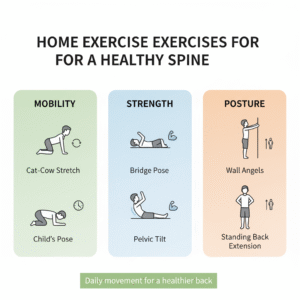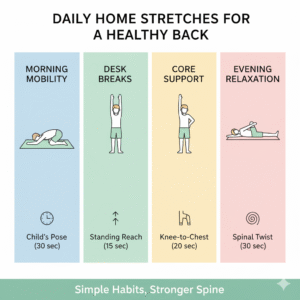
Your spine plays a vital role in almost every movement your body makes—it supports your posture, protects your nerves, and provides flexibility. However, with today’s sedentary lifestyles and long hours spent sitting, back pain and spinal stiffness have become increasingly common.
The good news is that you don’t need a gym to keep your spine strong and healthy. With a few simple home exercises, you can improve posture, relieve tension, and prevent future back problems.
💪 1. Cat-Cow Stretch (Spinal Mobility Exercise)
Purpose: Increases flexibility and improves spinal movement.
How to do it:
Start on your hands and knees in a tabletop position.
Inhale and arch your back, lifting your head and tailbone (Cow Pose).
Exhale and round your spine, tucking your chin toward your chest (Cat Pose).
Repeat slowly for 10–15 repetitions.
💡 This gentle motion helps reduce stiffness and promotes a healthy spinal curve.
🧎♀️ 2. Child’s Pose
Purpose: Gently stretches the lower back and relieves tension.
How to do it:
Kneel on the floor, bring your big toes together, and sit back on your heels.
Stretch your arms forward and lower your chest toward the floor.
Hold the pose for 30–60 seconds, breathing deeply.
✨ A calming stretch that promotes spinal relaxation and relieves stress.
🪑 3. Pelvic Tilt Exercise
Purpose: Strengthens the lower back and abdominal muscles for better spinal stability.
How to do it:
Lie on your back with knees bent and feet flat on the floor.
Tighten your core muscles and flatten your lower back against the ground.
Hold for 5 seconds, then relax.
Repeat 10–15 times.
🩵 Helps maintain proper posture and relieves lower back pain.
🧍♀️ 4. Standing Back Extension
Purpose: Counteracts the effects of sitting and helps prevent spinal stiffness.
How to do it:
Stand tall with your hands placed on your lower back.
Gently arch backward at your waist and hold for 5–10 seconds.
Return to standing and repeat 5 times.
💡 Ideal for people who work long hours at a desk or on a computer.
🧘♂️ 5. Bridge Pose
Purpose: Strengthens glutes, core, and lower back muscles that support the spine.
How to do it:
Lie on your back with knees bent and feet hip-width apart.
Press your feet into the floor and lift your hips upward.
Hold for 5–10 seconds, then slowly lower back down.
Repeat 10–12 times.
🏋️ Excellent for improving posture and spinal support.
🧍 6. Wall Angels
Purpose: Improves upper back strength and posture.
How to do it:
Stand with your back against a wall, feet a few inches away.
Place your arms in a “goalpost” position against the wall.
Slowly slide your arms up and down while keeping contact with the wall.
Repeat 10–15 times.
🌿 A great daily exercise to reduce slouching and shoulder rounding.
🧘♀️ 7. Knee-to-Chest Stretch
Purpose: Relieves pressure in the lower spine and reduces back tightness.
How to do it:
Lie flat on your back with knees bent.
Bring one knee to your chest, holding it gently with both hands.
Hold for 20–30 seconds, then switch legs.
Repeat 2–3 times per side.
💤 Perfect as part of your evening relaxation routine.
💡 Additional Tips for a Healthy Spine
Maintain good posture: Keep your back straight and shoulders relaxed while sitting or standing.
Avoid prolonged sitting: Take breaks every 30–45 minutes to stretch or walk.
Sleep right: Use a firm mattress and sleep on your back or side with a supportive pillow.
Stay hydrated: Dehydration can reduce spinal disc elasticity.
Strengthen your core: A strong core supports the spine and reduces strain.
🩺 When to See a Physiotherapist
If you experience chronic back pain, stiffness, or numbness, consult a qualified physiotherapist. They can assess your spinal health, guide you with personalized exercises, and treat any underlying conditions causing discomfort.
✅ Conclusion
A healthy spine is essential for a healthy life. By incorporating these simple home exercises into your daily routine, you can improve flexibility, strengthen your back, and maintain long-term spinal health.
🏡 Remember: a few minutes of movement each day can protect your spine for years to come!

